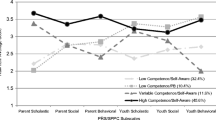Abstract
We tested a questionnaire assessing defenses in school age children and compared the results with their mothers' reports of the same. Thirty-four children (56% male, mean age 8.5) completed the Response Evaluation Measure for Youth (REM-Y) twice over three weeks. Simultaneously, mothers completed the parent version of this measure (REM-P) about their children. In these questionnaires, factor 1 defenses (less adaptive; broken down into intrapersonal and interpersonal defenses) are assessed separately from factor 2, or more adaptive, defenses. Only lower level, interpersonal defenses, such as acting out, were recognized by mothers in their children. The children's intrapersonal defenses, along with factor 2 reactions, were reported less by mothers than by children.
Similar content being viewed by others
References
Cramer P: Defense mechanisms in psychology today: further processes for adaptation. American Psychologist55(6): 637–646, 2000.
Stansbury K, Harris H: Individual differences in stress reactions during a peer entry episode: effects of age, temperament, approach behavior, and self-perceived peer competence. J Exp Child Psychol 76(1):50–63, 2000.
Erickson S, Feldman SS, Steiner H: Defense reactions and coping strategies in normal adolescents. Child Psychiatry Hum Dev 28(1): 45–56, 1997.
Freud A: The Ego and the Mechanisms of Defense, Vol 2., Madison, CT: International Universities Press, 1966.
Valliant GE: Ego Mechanisms of Defense: A Guide for Clinicians and Researchers. Washington DC: American Psychiatric Press, Inc., 1992.
Tuulio-Henriksson A, Poikolainen K, Aalto-Setala T, Lonnqvist J: Psychological defense styles in late adolescence and young adulthood: a follow-up study. J Am Acad Child Adolesc Psychiatry 36(8): 1148–1153, 1997.
Cramer P: Evidence for change in children's use of defense mechanisms. J Pers65(2): 233–47, 1997.
Cramer P, Brilliant MA: Defense use and defense understanding in children. J Pers69(2): 297–322, 2001.
Porcerelli J, Thomas S, Hibbard S, Cogan R: Defense mechanisms development in children, adolescents, and late adolescents. J Personality Asses 71(3):411–420, 2002.
Cramer P, Block J: Preschool antecedents of defense mechanism use in young adults: A longitudinal study. J Personality Soc Psychol 74(1):159–169, 1998.
Steiner H, Araujo KB, Koopman C: The response evaluation measure (REM-71): a new instrument for the assessment of defenses in adults and adolescents. Am J Psychiat 158 (3): 467–473, 2001.
Sjoback H: The Psychoanalytic Theory of Defensive Processes. New York: John Wiley & Sons, Inc., 1973.
Thienemann M, Shaw RJ, Steiner H: Defense style and family environment. Child Psychiat Hum Develpm 28(3):189–198, 1998.
Shaw RJ, Ryst E, Steiner H: Temperament as a correlate of adolescent defense mechanisms. Child Psychiat Hum Develpm 27(2): 105–114, 1996.
Araujo K, Ryst E, Steiner H: Adolescent defense style and life stressors. Child Psychiat Hum Develpm 30(1) 19–28, 1999.
Araujo K, Steiner H. Adolescent Defense Style as a Predictor of Problem Behaviors. Scientific Proceedings of the Annual Meeting of the American Academy of Child and Adolescent Psychiatry, 14: 94, 1998.
Perry JC, Cooper S: What do cross-sectional measures of defense mechanisms predict?, in Ego Mechanisms of Defense: A Guide for Clinicians and Researchers. ed. Valliant G. Washington, DC: American Psychiatric Press, pp195–216, 1992.
Steiner H, Erickson S, Araujo K, Williams S, McQuivey R: Adaptive style, coping reactions and defense reactions: new findings. Symposium presented at the 1996 meeting of the Am Acad Child Adolesc Psychiat (abstract S-29).
Crandall VC, Crandall VJ, Katkovsky W: A children's social desirability questionnaire. J Consulting Psychology29(1): 27–36, 1965.
Spielberger C, Edwards CD, Lushene RE, Mountuori J, Platzek D: STAIC: Preliminary manual for the state-trait anxiety inventory for children, Palo Alto, CA: Consulting Psychologists Press, Inc., 1973.
Luby JL, Steiner H: Concordance of parent-child temperament ratings in a clinical sample of adolescent girls. Child Psychiat Hum Develpm 23(4): 297–305, 1993.
Canning, EH Mental disorders in chronically ill children: case identification and parent-child discrepancy. Psychosomatic medicine, 56 (2), 104–108, 1994.
Myers J, Bean L: Two-factor index of social position (Appendix 3). In A Decade Later: A Follow-up of Social Class and Mental Illness. ed. Myers J & Bean L. New York: John Wiley & Sons, Inc., pp 235–237, 1968.
Feldman SS, Araujo KB, Steiner H: Defense mechanisms in adolescents as a function of age, gender, and mental health status. J Am Acad Child Adolesc Psychiat35(10): 1344–1354, 1996.
Seiffge-Krenke, I & Kollmar, F. Discrepancies between mothers' and fathers' perceptions of sons' and daughers' problem behaviour: a longitudinal analysis of parent-adolescent agreement on internalizing and externalizing problem behaviour. Journal of Child Psychology & Psychiatry & Allied Disciplines.39(5). 687–697, 1998.
Frauenglass M, Diaz R: Self regulatory functions of children's private speech: a critical analysis of recent challenges to Vygotsky's theory. Developmental Psychology21(2): 357–364, 1985.
Steiner H, (ED): Treating School-Age Children. San Francisco, CA: Jossey-Bass Inc., Publishers, 1997.
Harris ES, Canning RD, Kelleher KJ: A comparison of measures of adjustment, symptoms, and impairment among children with chronic medical conditions. J Am Acad Child Adolesc Psychiat 35 (8): 1025–1032, 1996.
McConaughy SH, Stanger C, Achenbach TM: Three-year course of behavioral/emotional problems in a national sample of 4-to 16-year-olds: I. Agreement among informants. J Amer Acad Child Adolesc Psychiat 31(5): 932–940, 1992.
Edelbrock C, Costello AJ, Dulcan MK, Conover NC, Kala R: Parent-child agreement on child psychiatric symptoms assessed via structured interview. J Child Psychol Psychiatry 27(2): 181–190, 1986.
Author information
Authors and Affiliations
Rights and permissions
About this article
Cite this article
Yasnovsky, J., Araujo, K., King, M. et al. Defenses in School Age Children: Children's Versus Parents' Report. Child Psychiatry Hum Dev 33, 307–323 (2003). https://doi.org/10.1023/A:1023088313470
Issue Date:
DOI: https://doi.org/10.1023/A:1023088313470



